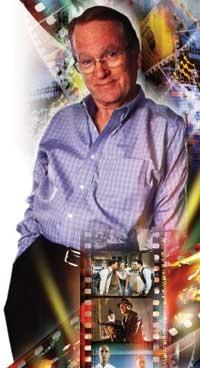Creating the Video Future

Photo illustration by Eric Yang Lowry photo by John Skalicky When George Lucas needed someone to restore the first three Star Wars films to their original glory for DVD, he turned to digital pioneer John Lowry. And when the James Bond film legacy needed to be rescued from the ravages of time, the studios called on Lowry as the best man for the job.
Why do Hollywood 's heaviest hitters go to Lowry and his partner, Ian Caven, to save their most valuable treasures and prepare them for future video technologies? Because Lowry's technique for using computers to restore movies has produced such stunning results that the DVD community is abuzz.
Their early work for Warner Bros. included North by Northwest, Gone with the Wind, Now Voyager, and Citizen Kane. Since then, Lowry Digital has grown to a staff of 60 and has been involved with many major restorations, including Snow White and the Seven Dwarfs, Singin' in the Rain, and the Indiana Jones and Star Wars collections.
I recently asked Lowry about his restoration process, which can create high-resolution digital masters that can be used as sources for not only present-day DVDs and HDTV broadcasts but also film prints, high-definition DVDs, and any future video format. We inevitably touched also on digital cinema, digital filmmaking, raising the quality of HDTV - and, of course, James Bond.
DVD transfers are usually scanned using the 480p (progressive) enhanced-definition or 1080i (interlaced) high-def formats. Why do you scan films at 4K, or 4,096 pixels, horizontal resolution - more than twice the 1,920-pixel resolution of the 1080i HDTV format?If I'm going to restore a film, my objective is to capture everything that is on that negative, which probably has a limit somewhere in the 3- to 4K range (click to see "The Lowry Process," PDF). If you scan it at high-def or even 2K, there's all kinds of information on that film that you just haven't got. If you scan at 4K, it captures everything on the film - everything. Most of the work we're currently doing is scanning the original final-cut camera negative - whenever possible we get back to the camera negative. We use a couple of 4K scanners that were selected for their very gentle handling of film. We create a digital master of everything on the negative, process it, and make a new "digital negative" that is just as good as the original camera negative in terms of resolution and grain structure, but without all the changes caused by age and wear and tear. We want it to look like what the director saw when he first screened his dailies - the first print made from the negative.




























































